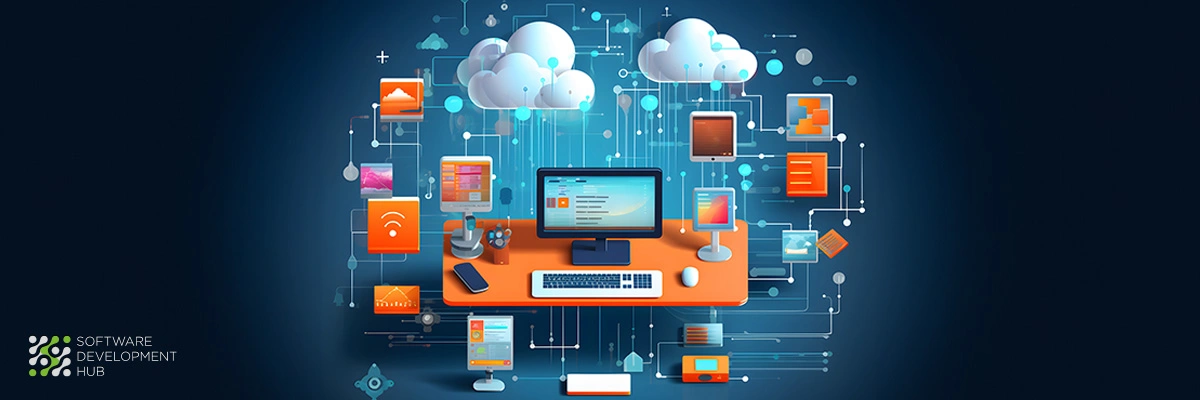Cloud-Native DevOps: Cloud Services in DevOps as a Service
Modern software teams have achieved something remarkable: they can deploy updates multiple times daily without service interruptions by combining cloud-native architecture with DevOps practices. This capability has changed the landscape of application development and delivery, turning continuous deployment from a distant goal into everyday reality.
The marriage between cloud-native architecture and DevOps creates an approach that both streamlines workflows and boosts team collaboration. This integration allows applications to scale horizontally and maintain resilience during failures while speeding up high-quality software delivery. When development teams implement automated testing and continuous integration, they reduce friction throughout the software lifecycle and move away from manual processes that slow progress.
What exactly makes cloud-native DevOps so effective for organizations? And how can teams properly implement it? These questions deserve careful consideration as more companies seek to improve their deployment capabilities.
We will examine how organizations can successfully implement cloud-native DevOps by looking at key architectural principles, essential service components, and proven patterns that lead to success. Additionally, we'll cover practical strategies for measuring performance and optimizing costs in your cloud-native DevOps implementation, including the use of CI/CD pipelines and other DevOps tools.
Cloud-Native Architecture Fundamentals for DevOps
Cloud-native architecture marks a significant shift in application design, development, and operation within cloud environments. While traditional infrastructure focuses on fixed hardware and manual operations, cloud-native systems prioritize flexibility, automation, and horizontal scaling to deliver better speed and responsiveness.
Defining Cloud-Native Architecture Principles
Cloud-native architecture stands on several key principles that set it apart from conventional approaches:
- Design for automation - Infrastructure provisioning and management happen through code, eliminating manual configurations
- Smart state management - Creating stateless components wherever possible to improve scalability and resilience
- Managed services preference - Using cloud provider services allows development teams to concentrate on application logic rather than infrastructure maintenance
- Defense in depth - Implementing multiple security layers beyond simple perimeter protection
- Continuous evolution - Systems must adapt to changing requirements through ongoing architectural refinement
Microservices as Building Blocks
Microservices serve as the foundation of cloud-native applications by decomposing monolithic systems into independent, loosely coupled services. Each microservice handles a specific business capability and operates independently from others. This approach allows development teams to work on individual components without impacting the entire application.
The communication between microservices occurs through well-defined APIs that function as connectors between these autonomous components. Such architecture offers exceptional flexibility - organizations can update specific services without needing to rebuild the entire application.
Containerization and Orchestration
Containers bundle application code with its dependencies, creating standardized units that function consistently across environments. Unlike virtual machines, containers utilize the host operating system kernel, making them lightweight and portable. Docker has emerged as the leading containerization platform for cloud-native applications, with immutable containers becoming increasingly popular for their consistency and security benefits.
As container deployments expand, orchestration becomes necessary. Kubernetes, now the industry-standard for container orchestration, automates deployment, scaling, and management of containerized applications. It performs essential functions including container scheduling, resource allocation, load balancing, and ensuring high availability through its self-healing capabilities. Platforms like Red Hat OpenShift build on Kubernetes to provide additional features for enterprise container management.
Infrastructure as Code (IaC) Implementation
Infrastructure-as-code converts manual infrastructure provisioning into automated, consistent, and repeatable processes. With this approach, infrastructure configurations exist as code files that can be version-controlled, tested, and deployed via the same CI/CD pipelines used for application code.
Popular IaC tools include:
- Terraform - Works across multiple cloud providers
- AWS CloudFormation - For AWS-specific deployments
- Azure Resource Manager (ARM) - For Azure environments
Beyond automation of infrastructure creation, IaC lets teams treat infrastructure configurations as software, bringing version control, peer review, and consistent deployment benefits to infrastructure management.
DevOps as a Service: Core Components
DevOps as a Service combines tools, practices, and automation capabilities that enable continuous application delivery in cloud environments. Organizations implementing this approach benefit from improved system health, enhanced performance, and reduced operational costs throughout the development lifecycle.
CI/CD Pipeline Automation in the Cloud
CI/CD pipelines stand at the center of cloud-native DevOps, automating the build, test, and release processes that previously required extensive manual effort. CI (Continuous Integration) ensures developers regularly merge their code changes into a central repository where automated builds and tests verify quality. CD (Continuous Delivery) takes this automation further into the deployment phase, preparing software for reliable production delivery.
What makes cloud-based CI/CD pipelines particularly valuable? They support sophisticated deployment strategies like canary releases and automated rollbacks, significantly reducing production risks. These pipelines also provide immediate feedback on code changes, helping teams identify and fix issues early—when corrections are least expensive and disruptive.
The CI/CD process typically involves several stages:
- Code commit to a shared repository (e.g., Git)
- Automated build and unit testing (CI)
- Integration testing
- Deployment to staging environments
- Acceptance testing
- Deployment to production (CD)
Tools like Jenkins, GitLab CI, and cloud-native CI/CD solutions like Tekton help teams implement and manage these pipelines effectively.
Monitoring and Observability Tools
Monitoring and observability, while related, serve different purposes in maintaining system health. Monitoring focuses on collecting data from individual components and triggering alerts when metrics cross predefined thresholds. Observability takes a more investigative approach, examining distributed system interactions to uncover the root causes of issues.
As industry experts note, "Monitoring is the when and what of a system error, and observability is the why and how".
Effective observability platforms collect three essential types of telemetry data:
- Metrics: Numerical values showing system performance
- Logs: Detailed records of events and transactions
- Traces: Information tracking requests across distributed services
Security Integration in DevOps Workflows
Security integration throughout the DevOps lifecycle—commonly called DevSecOps—transforms security from a final checkpoint into an ongoing concern. This approach establishes automated security gates at key points in CI/CD pipelines, creating multiple layers of protection.
These automated security checks:
- Scan Infrastructure as Code templates before deployment
- Analyze container images for vulnerabilities
- Validate compliance with regulatory standards
- Perform vulnerability scanning on code and dependencies
Contrary to traditional thinking that security slows development, properly implemented security automation actually maintains development velocity while providing robust protection. By detecting and addressing vulnerabilities during development, teams prevent costly security issues from reaching production environments.
Implementing Cloud-Native DevOps Patterns
Design patterns function as crucial blueprints for building resilient, scalable cloud-native applications. These architectural approaches offer standardized solutions to common distributed system challenges while helping organizations maximize cloud environment benefits.
Serverless Computing for DevOps Workflows
Serverless computing allows DevOps teams to build and deploy applications without managing the underlying infrastructure. With platforms like AWS Lambda, Azure Functions, and Google Cloud Functions, developers can concentrate solely on code rather than server provisioning or maintenance.
What makes serverless computing attractive for DevOps teams? It offers several key advantages:
- Significantly enhanced productivity through elimination of infrastructure management
- Reduced operational burden with no server maintenance requirements
- Simplified automation of CI/CD tasks including unit tests, deployments, and monitoring
- Cost efficiency through a pay-as-you-go model where charges apply only for compute time actually used
Event-Driven Architecture Pattern
Event-driven architecture utilizes events to trigger and communicate between decoupled services. This pattern involves three primary components:
- Event producers - generate events
- Event routers - filter and direct events
- Event consumers - receive and process events
The producer publishes an event to the router, which then filters and pushes events to appropriate consumers. This approach proves especially valuable for cloud-native applications by enabling systems to operate independently and process events asynchronously.
Event-driven architectures deliver additional benefits including fanout capabilities without custom code, real-time data flow facilitation, and support for team coordination across different regions and accounts.
Service Mesh Implementation
A service mesh creates a dedicated infrastructure layer that manages service-to-service communication in microservices architectures. Rather than writing communication logic directly into microservices, service meshes abstract this functionality into a parallel infrastructure layer using sidecar proxies. These proxies constitute the data plane, while management processes form the control plane.
For DevOps teams, service meshes like Istio provide several important capabilities:
- Centralized traffic management
- Enhanced security through mutual TLS (mTLS)
- Built-in resilience features
- Improved observability through comprehensive telemetry data collection
API Gateway Pattern for Microservices
The API gateway pattern establishes a single entry point for specific groups of microservices. It functions as a reverse proxy, routing client requests to appropriate services while handling cross-cutting concerns such as authentication and monitoring.
This pattern supports three main implementation approaches:
- Gateway routing - directs requests to appropriate services
- Gateway aggregation - reduces client chattiness by combining multiple requests
- Gateway offloading - centralizes cross-cutting functionality
For cloud-native applications, API gateways simplify client interfaces, enable flexible release processes, and strengthen security while decoupling clients from backend services.
Measuring Success in Cloud-Native DevOps
Measuring performance stands as a critical element of successful cloud-native DevOps implementation. After organizations establish proper architecture and workflows, they must quantify results to drive continuous improvement and demonstrate business value.
Cost Optimization Strategies
Managing cloud resources efficiently is essential for sustainable DevOps operations. How can teams control costs while maintaining performance?
Rightsize Your Resources by gathering comprehensive utilization data and eliminating over-provisioned instances. Many organizations waste significant budgets on underutilized resources that could be scaled down or eliminated.
Implement Automation for resource management to scale dynamically based on actual usage patterns. This ensures you only pay for resources when they're actually needed.
For specific cloud services, consider these approaches:
- Use Spot Instances which offer substantial discounts (up to 90%) for non-critical workloads by utilizing unused capacity in cloud providers
- Commit to Reserved Capacity for predictable workloads - this can provide up to 60% savings for services like Azure Database for PostgreSQL
Automate Cost Monitoring with cloud-native tools that provide visibility into spending patterns across all services. With this data in hand, schedule regular cost reviews to identify optimization opportunities and align technology decisions with business objectives.
Conclusion
Cloud-native DevOps marks a significant step forward in modern software development practices. Through the effective combination of microservices, containerization, and automated workflows, organizations can reach new levels of deployment efficiency and system reliability that were previously unattainable.
What specific benefits do teams get when adopting cloud-native DevOps? The advantages are substantial and multi-faceted. Automated CI/CD pipelines dramatically cut deployment times while maintaining high quality standards throughout the process. Comprehensive monitoring and observability tools offer deep insights into system performance, allowing teams to identify and address issues before they impact users. Additionally, integrated security measures protect applications throughout their entire lifecycle, reducing vulnerability without slowing development.
Measurement plays a crucial role in continuous improvement efforts. DORA metrics provide concrete benchmarks for evaluating DevOps performance, helping teams track their progress against industry standards. Meanwhile, cost optimization strategies ensure operations remain sustainable over time. When organizations implement these practices effectively, they typically see notable improvements in deployment frequency, lead times, and overall system reliability.
Cloud-native DevOps is not a static field – it will continue evolving as technologies advance and best practices mature. Teams must stay current with emerging patterns and tools to maintain their competitive advantage in software delivery. Organizations that fully embrace these principles position themselves well for future growth and innovation in today's rapidly changing technology landscape.
Software teams that invest in cloud-native DevOps now are not just solving today's challenges – they're building the foundation for tomorrow's success.
Categories
About the author
Share
Need a project estimate?
Drop us a line, and we provide you with a qualified consultation.








